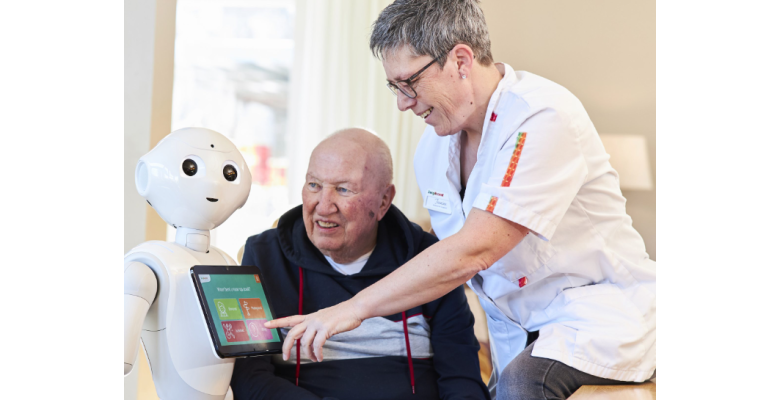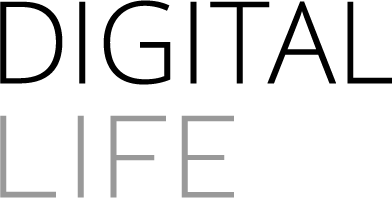Social Robotics in Eldercare
Home > Projects > Sociale Robotica in de Ouderenzorg

In 2019, ZorgAccent, in collaboration with partners Menzis, DigiNova and the Digital Life research group of the Amsterdam University of Applied Sciences, applied for and received a subsidy from the Dutch Healthcare Authority from the innovation fund to explore the possibilities of using the social robot Karel (Pepper) for both healthcare employees and clients of ZorgAccent.
The main goal of the Robotics project within ZorgAccent is to contribute as a support tool in elderly care to promote self-management, well-being (feeling of safety) and well-being of clients; to support healthcare workers in their day-to-day work and avoid the high workload they experience, and finally to potentially reduce healthcare costs.
ZorgAccent has been acquainted with the social robot Pepper for three years (including the COVID-19 pandemic that started in March 2020, which unfortunately also meant that many activities had to be discontinued). This introduction has created the opportunity to explore different user cases with different client groups. Work has started in work packages of six months, with sprints of one to two months.
The robotics project had a duration of three years at ZorgAccent, from 2019 to 2021. This gave the opportunity to explore different user cases with different client groups. Work was done in work packages of six months; with the idea that the robot will be deployed elsewhere every six months. The aim of this is to be able to determine after six months whether there is sufficient enthusiasm to leave the robot in the relevant department. The pilot project started with a route on the Krönnenzommer. Which clients/departments are/is the most suitable and where can added value be experienced for both clients and care staff through the use of the social robot?
Prior to the implementation of the robot Pepper (later changed to the name ‘Karel’), an inventory was made of the most important end users in the robotics project of ZorgAccent. Residents/clients, healthcare workers and practitioners were identified as the main users of the robot. Family/informal carers may be able to use the robot as a source of information (eg psycho-education). A study was then set up, consisting of two focus groups and interviews with residents and visitors, which focused on questions such as: what they encountered during their stay, what things they would like to change and what possible expectations they have with regard to the use of robotics in their care process.
Using Karel with the ReceiptApp has resulted in a number of lessons learned that are valuable for the next phases. A first result that has been achieved is that clients and employees were able to get to know Karel in a simple way, which they also experienced as pleasant. In addition, various technical barriers have been removed, making Karel available 24/7 and it has become apparent that the dialogue function is still insufficient to be able to have a clear interaction between client and Karel. Finally, the acceptance of Karel in terms of attractiveness (pleasant, friendly, etc.) and attitude is largely positive.
Various applications have been developed for this research, which are at the service of all end users, namely: the ReceiptApp, HuiskamerApp and the OefenApp.
This pilot project has yielded a lot of insights, knowledge and experience that is valuable not only for ZorgAccent, but also for other Dutch healthcare institutions. Below, a conclusion will be drawn per subject based on the results and lessons learned during this project. A number of general recommendations can be made from the evaluations to increase the implementation of social robots in healthcare institutions.
1) Use and acceptance
If one looks at the results of the evaluations, it can be concluded that the employees of ZorgAccent in the GRZ department do not react enthusiastically to the social robot and did not find its added value for their daily activities clearly visible. However, it should be noted that this group of employees has experienced the development of the robot from the very beginning and has been able to see the expansion process of the robot’s modules up close step by step. On the one hand, this is very positive, because the needs and wishes of the employees are directly translated into the various modules. On the other hand, this may have led to too high expectations regarding the functionalities of the robot and that the employees experienced the process as slow. These findings are consistent with what we know from the literature on involving end-users in the development process. In addition, it unfortunately also appears to be the case during this evaluation period that the WIFI worked poorly, as a result of which the robot often failed. This too may have had a more negative impact on the results obtained.
The Psycho Geriatrics department of ZorgAccent has recently started a pilot project to get acquainted with the robot for the first time. The first results are very positive for some of the clients and employees. Using the robot for a longer period of time will provide an even better picture of the precise added value in this department.
2) Embedding in the daily work of healthcare workers
Just enthusing healthcare workers to use the robot is not enough. Just as there are guidelines for working hygienically in healthcare (which means that you often have to wash your hands), there should also be a guideline/appointment within the team to, for example, switch on the robot immediately upon entering a service.
3) Composition of target groups
The changing group of clients in the living rooms of the GRZ and the attitude towards the client’s robot have a major influence on the group process and the use of the robot. If a new client comes into the living room and an enthusiastic group of clients is working with the robot at that time, there is a greater chance that the new client will come into contact with the robot sooner if the client’s circumstances allow it (for example, mental health). and physical health aspects).
The opposite (a more negative attitude) has also been observed in clients and this can sometimes also be influenced by the healthcare staff in both negative and positive sense. One employee is much more alert to the use of the robot in the group process with the clients, while another healthcare employee can reinforce the more negative attitude of clients by also speaking negatively about the robot. This process of influencing healthcare workers and clients should not be underestimated for a successful implementation of social robots in healthcare institutions. The employees of the care technology team of ZorgAccent have played a crucial role in creating a positive attitude and atmosphere of social robotics in the workplace. Only, of course, they are in the minority and in many institutions they consist of smaller groups. Continued investment in healthcare technology teams that can guide technological innovations in healthcare and train colleagues is a crucial component for successful implementation of social robotics in healthcare.
4) Direct and indirect profit
A difference has been observed between the direct profit that a social robot can offer for the clients and indirect profit for the care worker.
Such as, for example, when a client is engaged in exercises and does them together with the robot, so that the client does the exercises more often so that recovery can be promoted.
There is also the direct profit that the robot can deliver to the work of the care worker himself. For example, making a shopping list so that the employee no longer has to do it himself. These direct and indirect gains also differ per department of a healthcare institution (a PG or a GRZ). As a result, a social robot can be used in many different ways, but it is certainly necessary to first map out the wishes and requirements per department of a healthcare institution, because a one-size-fits-all approach will not meet the diversity of wishes. and requirements that healthcare workers and clients have with regard to the robot.
Images & Video


